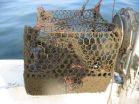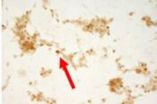(Press-News.org) Thousands of fishing traps are lost or abandoned each year in U.S. waters and become what are known as derelict traps, which continue to catch fish, crabs, and other species such as turtles. These traps result in losses to habitat, fisheries, and the watermen who depend on the resources--losses that are largely preventable, according to a newly published NOAA study.
The report, published in the Marine Pollution Bulletin, is the first of its kind to examine the derelict fish trap problem, and so-called "ghost fishing," nationally, and recommends actions to better manage and prevent it.
"Before this report, the marine debris community lacked comparable data on derelict traps," said Courtney Arthur, research specialist for NOAA's Marine Debris Program and lead author of the study. "We had different pieces of information, but not a whole picture. This paper connects those pieces and identifies areas where we need to focus our efforts."
The report looks at the results of seven NOAA-funded studies in different fisheries across the U.S., and compares the severity of the problem, and common management challenges across the regions. It also reports certain findings from the studies for the first time in peer-reviewed literature, such as estimates of derelict trap numbers and how long they remain in the environment.
"People may not realize that derelict traps can catch not just the target species of the fishery, but also other animals including threatened and endangered species where populations are already very low. Derelict traps can also harm sensitive habitats like coral reefs and salt marsh so they have a bigger impact than might be anticipated," said Ariana Sutton-Grier, Ph.D., NOAA's National Ocean Service ecosystem science adviser and co-author of the study.
Researchers concluded that derelict traps have a cumulative, measurable impact which should be considered in fishery management decisions. They identified several key gaps in research and suggested a management strategy that emphasizes a collaborative approach, including:
studying how derelict traps and ghost fishing affect fishery stocks and the fishing economy
involving the fishing industry in collaborative projects to find solutions to ghost fishing
examining the regional challenges to derelict traps to find effective policy solutions to manage, reduce, and prevent gear loss
"By providing this comprehensive study, we allow resource managers to make more informed decisions that make sense for them and for the fishing industry," said Holly Bamford, Ph.D., assistant NOAA administrator for the National Ocean Service and a co-author of the report. "Marine debris is a continued threat to resilient ecosystems and navigation safety, and by working together we can find better solutions to keep coastal communities, economies and ecosystems healthy."
Fisheries in the study include the Dungeness crab fisheries in Alaska and Puget Sound; the blue crab fisheries in Maryland, Virginia, and North Carolina; the spiny lobster fishery in Florida; and the coral reef fish fishery in the U.S. Virgin Islands.
All seven fisheries contained derelict traps, with average numbers ranging from five to 47 traps per square kilometer. Further, between five and 40 percent of all the derelict traps examined showed evidence of ghost fishing. The length of time a trap continued to ghost fish depended on the environmental conditions and trap design, but in every fishery, ghost fishing occurred longer than anticipated based on assumptions about gear degradation.
INFORMATION:
Since 2005, the NOAA Marine Debris Program has worked with partners, including fishing communities and researchers, to better understand derelict fishing traps and their impacts in important fisheries across the nation. Many of these investigations were conducted by NOAA staff from the NOAA Chesapeake Bay Office, the Southeast Fisheries Science Center, and NCCOS's Center for Coastal Monitoring and Assessment, and represent an effort to enhance NOAA's marine debris knowledge and capabilities.
NOAA's mission is to understand and predict changes in the Earth's environment, from the depths of the ocean to the surface of the sun, and to conserve and manage our coastal and marine resources. Join us on Facebook, Twitter and our other social media channels.
NOAA's Marine Debris Program reports on the national issue of derelict fishing traps
2014-08-27
ELSE PRESS RELEASES FROM THIS DATE:
Taking aim at added sugars to improve Americans' health
2014-08-27
Now that health advocates' campaigns against trans-fats have largely succeeded in sidelining the use of the additive, they're taking aim at sugar for its potential contributions to Americans' health conditions. But scientists and policymakers are still wrangling over the best way to assuage the nation's insatiable sweet tooth, according to an article in Chemical & Engineering News (C&EN), the weekly news magazine of the American Chemical Society.
In the article, Stephen Ritter, a senior correspondent at C&EN, notes that growing evidence suggests the overconsumption of ...
Participants of cardiac clinic trials do not represent real world patients, study finds
2014-08-27
A new analysis of clinical trial participation in the largest ongoing observational study of U.S. heart attack patients has found participants are not representative of the larger patient base, according to a study led by Women's College Hospital cardiologist Dr. Jay Udell. The study authors call into question the general applicability of the findings to the wider population, and suggest the use of broader enrollment criteria and existing patient registries to increase trial participation.
"We know that clinical trials can be tremendously expensive and a huge burden on ...
Promising new cancer therapy uses molecular 'Trash Man' to exploit a common cancer defense
2014-08-27
While many scientists are trying to prevent the onset of a cancer defense mechanism known as autophagy, researchers at Virginia Commonwealth University Massey Cancer Center are leveraging it in a new therapy that causes the process to culminate in cell death rather than survival. The novel treatment strategy targets the p62 protein, which is often referred to as the "Trash Man" due to its role in disposing unwanted cellular proteins during autophagy. Results from preclinical experiments suggest this experimental treatment approach could be particularly effective against ...
Dartmouth isolates environmental influences in genome-wide association studies
2014-08-27
(Lebanon, NH 8/27/14)—Dartmouth cancer researchers developed and tested an advanced statistical model to evaluate the genetic and environmental interactions that contribute to disease as published yesterday in Human Genetics.
The approach fills a gap in current analyses. Complex diseases like cancer usually arise from complex interactions among genetic and environmental factors. When many such combinations are studied, identifying the relevant interactions versus those that reflect chance combinations among affected individuals becomes difficult. In this study, the ...
Veld Fires in South Africa
2014-08-27
South Africa is entering what is described by the Volunteer Wildfire Services of South Africa as "Cape Fire Season." The Eastern Cape provincial government warned residents in certain parts of the province on Monday (8/25) of strong winds and veld fires. A high veld fire danger rating is expected in the north-western interior and along the coast in the Great Kei and Mnquma area. Strong winds often occurred along coastal regions, and during thunderstorms. The thunderstorms bring lightning strikes and subsequent fire and the wind serves to spread the fire from one place ...
Karina's remnants drawn into Hurricane Marie's spin
2014-08-27
Karina finally became a remnant low pressure area after roaming around in the Eastern Pacific for two weeks. Satellite data on August 27 showed that the now shapeless former hurricane was being drawn into nearby Hurricane Marie's circulation.
The last bulletin on Karina was issued by the National Hurricane Center on August 27 at 0300 UTC (11 p.m. EDT on Tuesday, August 26).
At that time, Karina's maximum sustained winds were near 30 mph (45 kph). It was centered near latitude 15.9 north and longitude 126.5 west. That's 1,185 miles (1,905 km) west-southwest of the southern ...
Group identity emphasized more by those who just make the cut
2014-08-27
People and institutions who are marginal members of a high-status or well-esteemed group tend to emphasize their group membership more than those who are squarely entrenched members of the group, according to new research published in Psychological Science, a journal of the Association for Psychological Science.
Research has long shown that people prefer to be in groups that are thought to have higher status or cultural value as a way of boosting self-image and projecting an impressive image to others. Despite the fact that separations between groups are often arbitrary, ...
Baicalin suppresses iron accumulation after substantia nigra injury
2014-08-27
A growing number of studies have shown that excessive iron is closely associated with the pathogenesis of Parkinson's disease. Previous studies from Chunyan Guo and co-workers from Capital Medical University in China have shown that baicalin prevented iron accumulation after substantia nigra injury, reduced divalent metal transporter 1 expression, and increased ferroportin 1 expression in the substantia nigra of rotenone-induced Parkinson's disease rats. However, the relationship between iron concentration and transferrin expression is still unclear. Based on the previous ...
Factors predicting functional recovery of the upper limb after peripheral nerve injuries
2014-08-27
Currently, the main factors thought to be associated with outcomes after the repair of peripheral nerve injuries are the age of the patient, mechanism of injury, nerve injured, injury location, defect length, repair time, repair method, operation technique, and repair materials. However, despite numerous studies of outcomes after the repair of peripheral nerve injuries, there is no agreement regarding the independent predictors of a good prognosis, and the dose-effect relationship of the predictors has not been quantified. A study by Dr. Bo He and co-workers from the First ...
Gifts that generate gratitude keep customers loyal
2014-08-27
Despite major retailers investing tens of millions of dollars a year into loyalty programs, they are a dying breed, with customers struggling to see the benefits of signing up, according to QUT research.
But benefits that stimulate gratitude in customers have the power to strengthen the seller-customer relationship and ensure loyalty, researchers Dr Syed Hasan, Professor Ian Lings, Associate Professor Larry Neale and Dr Gary Mortimer, from QUT's School of Advertising, Marketing and Public Relations, found.
Lead researcher Dr Hasan, a Postdoctoral Research Fellow, said ...



